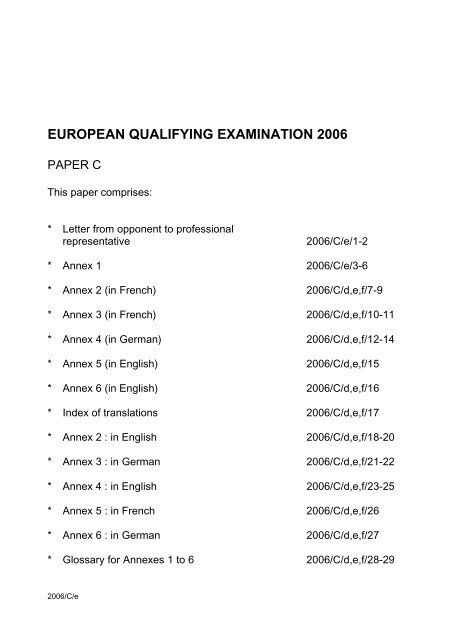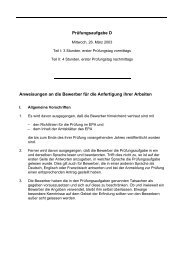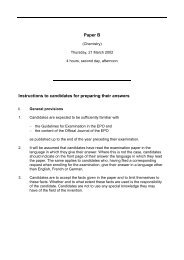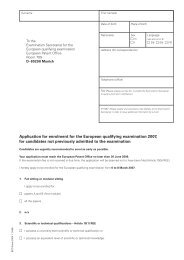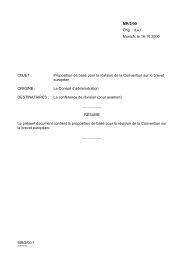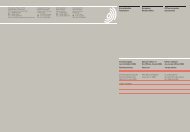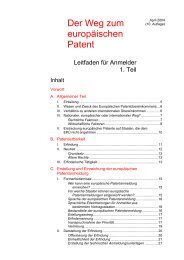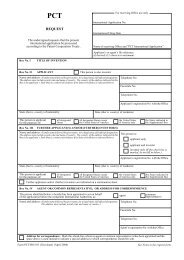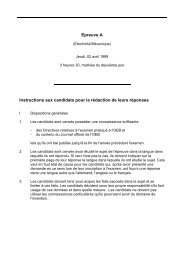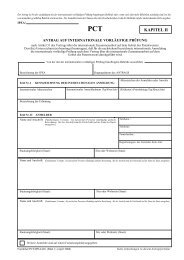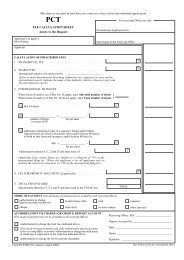EUROPEAN QUALIFYING EXAMINATION 2006
EUROPEAN QUALIFYING EXAMINATION 2006
EUROPEAN QUALIFYING EXAMINATION 2006
Create successful ePaper yourself
Turn your PDF publications into a flip-book with our unique Google optimized e-Paper software.
<strong>EUROPEAN</strong> <strong>QUALIFYING</strong> <strong>EXAMINATION</strong> <strong>2006</strong><br />
PAPER C<br />
This paper comprises:<br />
* Letter from opponent to professional<br />
representative<br />
<strong>2006</strong>/C/e/1-2<br />
* Annex 1 <strong>2006</strong>/C/e/3-6<br />
* Annex 2 (in French) <strong>2006</strong>/C/d,e,f/7-9<br />
* Annex 3 (in French) <strong>2006</strong>/C/d,e,f/10-11<br />
* Annex 4 (in German) <strong>2006</strong>/C/d,e,f/12-14<br />
* Annex 5 (in English) <strong>2006</strong>/C/d,e,f/15<br />
* Annex 6 (in English) <strong>2006</strong>/C/d,e,f/16<br />
* Index of translations <strong>2006</strong>/C/d,e,f/17<br />
* Annex 2 : in English <strong>2006</strong>/C/d,e,f/18-20<br />
* Annex 3 : in German <strong>2006</strong>/C/d,e,f/21-22<br />
* Annex 4 : in English <strong>2006</strong>/C/d,e,f/23-25<br />
* Annex 5 : in French <strong>2006</strong>/C/d,e,f/26<br />
* Annex 6 : in German <strong>2006</strong>/C/d,e,f/27<br />
* Glossary for Annexes 1 to 6 <strong>2006</strong>/C/d,e,f/28-29<br />
<strong>2006</strong>/C/e
- 1 - Opponent’s letter<br />
Ghent, 01.03.<strong>2006</strong><br />
European Patent Attorney<br />
Mr Ken Heine<br />
Herrenstrasse 55<br />
80539 Munich<br />
GERMANY<br />
Livenbroy Enterprise<br />
Beierenstraat 59<br />
9000 Ghent<br />
BELGIUM<br />
Dear Mr Heine,<br />
We, Livenbroy Enterprise, wish to file opposition against the European patent of Stelam<br />
Factories published under no EP-B- 1200300 (Annex 1).<br />
This patent results from the divisional application of a parent application EP-A-1100100,<br />
the granted patent of which we have opposed. Despite our solid argumentation based<br />
on extremely relevant prior art, the patent from the parent application was maintained in<br />
amended form. We suspect the opposition division of partiality. Therefore we would like<br />
to request that we do not have the same opposition division in this opposition procedure.<br />
Is this possible?<br />
After the issue of the interlocutory decision on the patent from the parent application,<br />
Stelam Factories sued us for infringement in Belgium. It is therefore urgent for us to<br />
reach a decision rapidly on the opposition of the patent from the divisional application in<br />
order to establish a common strategy for both patents. How can we achieve this?<br />
Please note that the subject-matter of granted claim 1 of the divisional application is<br />
broader than the granted subject-matter of the parent application. Is this allowable?<br />
<strong>2006</strong>/C/e/1 .../...
- 2- Opponent’s letter<br />
File inspection revealed that during the examination before the EPO of the patent<br />
application of Annex 2 its applicant submitted additional technical information. Annex 3<br />
contains this additional technical information. Can this document be of any use?<br />
We would like to give you the following information concerning the granted claims of<br />
Annex 1:<br />
Claims 1 to 4 find support in the priority document, the originally filed parent application<br />
and the originally filed divisional application.<br />
Claims 6 and 7 find support in the originally filed parent application and the originally<br />
filed divisional application.<br />
Claim 5 and its support in the description, paragraph [011], were added during<br />
prosecution of the divisional application before the examining division. Support for this<br />
amendment derives only from the abstract of this application.<br />
With our best regards,<br />
Åsa Hi<br />
(Director)<br />
Enclosures:<br />
Annex 1: Description and claims<br />
Annex 2: EP-A-0453584<br />
Annex 3: fax of 30.10.2000<br />
Annex 4: DE-A-19920627<br />
Annex 5: Technology Today, 68 (1999)<br />
Annex 6: WPI/Derwent abstract<br />
<strong>2006</strong>/C/e/2
(19)<br />
Europäisches Patentamt<br />
European Patent Office<br />
Office européen des brevets<br />
Annex 1<br />
(11) EP 1 200 300 B1<br />
(12) <strong>EUROPEAN</strong> PATENT SPECIFICATION<br />
(45) Date of publication and mention<br />
of the grant of the patent:<br />
(51) Int. Cl. 7 : C10M171/00<br />
13.07.2005 Bulletin 2005/28<br />
(21) Application number: 03123456.7<br />
(22) Date of filing: 11.12.2000<br />
(54) Electrorheological fluids<br />
Fluides électrorhéologiques<br />
Elektrorheologische Flüssigkeiten<br />
(84) Designated Contracting States:<br />
AT BE DE DK ES FR GB IT LU NL SE<br />
(30) Priority:<br />
14.12.1999 BE 19841974<br />
(73) Proprietor:<br />
STELAM FACTORIES<br />
1000 Brussels (BE)<br />
(72) Inventor:<br />
Electrique, Paul<br />
1010 Brussels (BE)<br />
(43)<br />
(62)<br />
Date of publication of application:<br />
28.05.2003 Bulletin 2003/22<br />
Document number of the earlier application<br />
in accordance with Art. 76 EPC:<br />
00876543.2 / 1 100 100<br />
(74) Representative:<br />
Cereal, Bruno<br />
Maisstraat 333<br />
1020 Brussels (BE)<br />
Note: Within nine months from the publication of the mention of the grant of the European patent, any person<br />
may give notice to the European Patent Office of opposition to the European patent granted. Notice of opposition<br />
shall be filed in a written reasoned statement. It shall not be deemed to have been filed until the opposition fee<br />
has been paid (Art. 99(1) European Patent Convention).<br />
<strong>2006</strong>/C/e/3 .../...
- 2 - Annex 1<br />
5<br />
[001] The present application concerns electrorheological fluids (ERFs). Such a fluid<br />
undergoes rapid, reversible change in its viscosity through application of an electric field.<br />
Before applying the electric field the fluid flows freely like a liquid. With the application of<br />
the electric field the viscosity of the fluid is greatly increased. When the field is removed<br />
the fluid flows again freely like a liquid. The great strength of ERFs is their speed of<br />
response. ERFs change from liquid to solid in approximately 1 millisecond. A known<br />
ERF consists of an electric insulating oily medium, typically called in this art “base oil”,<br />
with solid particles dispersed therein.<br />
10<br />
[002] Silica gel, starch or metal compounds can be used as particles in ERFs.<br />
15<br />
[003] Starch is the most used in the art since it is well-known that an ERF comprising<br />
starch particles displays a satisfactory electrorheological effect.<br />
Starch is commonly produced from potatoes or corn, these being widely available and<br />
cheap. The types of starch from potatoes and corn are similar and can be used with<br />
equal effect in ERFs. However, the dispersion stability of starch particles in ERFs is not<br />
satisfactory since they tend to sediment on storage.<br />
20<br />
[004] The present inventors have now found that if starch is combined with another<br />
natural polymer, the particles formed show enhanced dispersion stability in ERFs<br />
compared to the particles made out of starch alone.<br />
25<br />
[005] A first aspect of the present invention is therefore an ERF comprising a major<br />
amount of a base oil and a minor amount of dispersed particles, each particle consisting<br />
of a first natural polymer which is mixed with a second, different, natural polymer. In a<br />
preferred embodiment of the present invention the first natural polymer is starch and the<br />
second natural polymer is acacia gum. In another preferred embodiment of the present<br />
invention the starch is obtained from corn.<br />
<strong>2006</strong>/C/e/4 .../...
- 3 - Annex 1<br />
[006] The base oil is usually selected from the group consisting of silicone oil, mineral<br />
oil, crude oil, olive oil, and their mixtures. The preferred base oil is crude oil.<br />
5<br />
10<br />
[007] A further aspect of the present invention is an ERF for use in pipelines, which<br />
comprises (i) a major amount of crude oil, (ii) a minor amount of dispersed particles and<br />
(iii) an additive useful for the protection of the pipeline from interaction with the dispersed<br />
particles. Each dispersed particle comprises starch and a second natural polymer as a<br />
core and a metallic coating, which covers the mixture of starch and the second polymer.<br />
The metallic layer enhances the electrorheological effect. It has surprisingly been found<br />
that these metal coated particles of a mixture of starch and a second natural polymer<br />
allow the ERF to perform within a broad temperature range. This allows the particles to<br />
be used in various environments where an ERF is needed.<br />
15<br />
[008] The most appropriate particles are spherical or almost spherical and have an<br />
average particle diameter of about 10 to about 100 micrometers, more preferably of<br />
about 20 to about 30 micrometers.<br />
20<br />
[009] The metal-coated particles show satisfactory dispersion stability. We consider that<br />
this is due to the low density of the core material, which counterbalances the higher<br />
density of the metallic coating layer.<br />
25<br />
[010] A particularly interesting use of an ERF containing metal-coated particles is the<br />
repair of leaking crude oil pipelines by dispersing metal-coated particles in the crude oil<br />
at a point upstream of the leakage to form an ERF and applying an electric field to<br />
solidify the ERF until the pipeline is repaired.<br />
[011] The electrorheological effect achieves a maximum when the metal of the coating<br />
layer is nickel.<br />
<strong>2006</strong>/C/e/5 .../...
- 4 - Annex 1<br />
Claims<br />
5<br />
1. An electrorheological fluid (ERF) comprising a major amount of a base oil and a<br />
minor amount of dispersed particles, each particle consisting of a first natural<br />
polymer which is mixed with a second, different, natural polymer.<br />
2. The ERF of claim 1 wherein the base oil is crude oil and the mixed natural<br />
polymers are starch and acacia gum.<br />
10<br />
3. The ERF of claim 2 wherein the starch is obtainable from corn.<br />
15<br />
4. An ERF for use in pipelines comprising (i) a major amount of crude oil, (ii) a minor<br />
amount of dispersed particles, each particle comprising a mixture of starch and a<br />
second natural polymer as a core, which core is coated with a metallic layer, and<br />
(iii) an additive useful for the protection of the pipeline.<br />
5. The ERF of claim 4 wherein the metallic layer is made of nickel.<br />
20<br />
6. The ERF of claims 1 or 4 wherein the average particle diameter is of about 20 to<br />
about 30 micrometers.<br />
7. A method of repairing leakages of crude oil pipelines by dispersing metal-coated<br />
particles into the crude oil upstream of the point of leakage to form an ERF and<br />
applying an electric field to solidify the ERF until the pipeline is repaired.<br />
<strong>2006</strong>/C/e/6
- 1 - Annexe 2<br />
EP 0 453 584 A1<br />
5<br />
10<br />
15<br />
Date de publication : 12.04.1998 Bulletin 1998/15<br />
Int. Cl. 6 :<br />
C10M171/00<br />
Numéro de dépôt : 97107222.2<br />
Date de dépôt : 22.10.1997<br />
Etats contractant désignés : AT BE CH CY DE DK ES FR GB IT LI LU NL<br />
Demandeur :<br />
Guy Nesse et Cie<br />
10, rue de la Vieille Pompe<br />
76016 Paris (FR)<br />
Inventeur :<br />
Aimé Gniole<br />
5, rue de la Forêt<br />
50300 Avranches (FR)<br />
Mandataire :<br />
Bade Waisère<br />
25, Place de l'Homme de Fer<br />
67000 Strasbourg (FR)<br />
Méthode de transport de fluides électrorhéologiques<br />
20<br />
[001] La présente invention concerne une méthode de transport d'un fluide<br />
électrorhéologique (FER).<br />
25<br />
[002] L'effet électrorhéologique est la propriété observée dans certains fluides lorsqu'un<br />
champ électrique est généré à l'intérieur du fluide, ce qui entraîne un épaississement<br />
rapide du liquide ou, avec un champ suffisamment fort, sa solidification.<br />
30<br />
[003] Un aspect de la présente invention concerne une méthode pour transporter un<br />
fluide, comprenant: la transformation du fluide en un FER, la formation à l'intérieur du<br />
fluide d’un champ électrique entre deux plaques espacées à l'intérieur du fluide, le<br />
déplacement des plaques et du FER solidifié, et ensuite la reduction du champ<br />
électrique pour permettre au FER de s'écouler à partir des plaques. Cette méthode peut<br />
être utilisée avantageusement pour séparer le pétrole brut de l'eau de mer en cas de<br />
déversement accidentel.<br />
<strong>2006</strong>/C/d,e,f/7 .../...
- 2 - Annexe 2<br />
[004] Le pétrole brut est transformé en un FER par addition d'une substance polarisable.<br />
La substance peut se présenter sous la forme de particules, telles que du sable, du<br />
graphite, des oxydes métalliques et divers polymères.<br />
5<br />
10<br />
[005] La substance polarisable préférée est l'amidon, car il forme un FER<br />
particulièrement efficace. Une propriété intéressante de l'amidon est sa faible capacité<br />
de gonflement, ce qui rend les dispersions d'amidon stables dans le pétrole brut. Il est<br />
possible d'utiliser de l'amidon de diverses origines, même si de petites différences de<br />
structure ont été observées. L'amidon de pomme de terre est l’un des amidons les plus<br />
couramment utilisés.<br />
15<br />
[006] Plutôt que d'ajouter l'amidon au pétrole brut après un déversement accidentel,<br />
cette substance peut être ajoutée au pétrole avant son transport par pétrolier. Pour<br />
empêcher que la substance particulaire ne se dépose pendant le transport, une pompe<br />
ou un agitateur peuvent être nécessaires dans le navire qui la transporte.<br />
20<br />
[007] Pour avoir un équipement de transport plus simple et éviter pompes et agitateurs,<br />
d’autres particules ont été proposées, qui associent un effet électrorhéologique amélioré<br />
et une stabilité de dispersion accrue. Elles ont été utilisées avec succès comme<br />
alternatives aux particules d'amidon. Ces alternatives sont des particules de résine<br />
synthétique ou des particules faites de mélanges d'amidon et d'au moins un autre<br />
polymère sélectionné parmi le groupe des gommes, telles que la gomme guar, la<br />
gomme arabique et la gomme karaya.<br />
25<br />
30<br />
[008] Un avantage particulier des particules faites de mélanges d'amidon et d'une<br />
gomme réside dans le fait qu'elles procurent des dispersions stables même à de très<br />
faibles concentrations dans le pétrole, ce qui est économiquement avantageux. Sans<br />
vouloir être lié à telle ou telle théorie, on pense que le polymère additionnel modifie la<br />
surface extérieure de la particule d'amidon et améliore les propriétés de dispersion. Il<br />
convient donc de veiller, pendant la préparation de ces particules, à ce que d'autres<br />
constituants ne se déposent pas sur la surface extérieure.<br />
<strong>2006</strong>/C/d,e,f/8 .../...
- 3 - Annexe 2<br />
Revendication<br />
5<br />
Méthode de transport d'un fluide électrorhéologique (FER), comprenant la formation à<br />
l'intérieur du fluide d’un champ électrique entre deux plaques espacées à l'intérieur dudit<br />
fluide afin d'épaissir le fluide entre les plaques, le transport des plaques et du FER<br />
épaissi, et ensuite la réduction du champ électrique afin de laisser le FER s'écouler à<br />
partir desdites plaques.<br />
<strong>2006</strong>/C/d,e,f/9
TELECOPIE REÇUE PAR L'OEB LE 30.10.2000<br />
- 1 - Annexe 3<br />
Strasbourg, 30.10.2000<br />
Office européen des brevets<br />
80298 Munich<br />
ALLEMAGNE<br />
Bade Waisère<br />
Mandataire en brevets européen<br />
25, Place de l'Homme de Fer<br />
67000 Strasbourg<br />
FRANCE<br />
Demande de brevet européen No. 97107222.2 (EP 0453584)<br />
Guy Nesse et Cie<br />
Notre référence : P8516EP/BW<br />
Messieurs,<br />
Nous produisons ci-après de nouvelles données expérimentales dans le cadre de la<br />
requête de la division d'examen relative à la demande européenne 97107222.2<br />
(EP 0453584) déposée au nom de Guy Nesse et Cie. Ces données montrent que des<br />
particules polarisables comprenant un mélange de deux polymères naturels améliorent<br />
la stabilité de dispersion dans du pétrole brut.<br />
Quatre expériences (E-1, E-2, E-3 et E-4) ont été menées, chacune avec des particules<br />
de composition différente. Le temps de décantation des particules dispersées à partir<br />
des compositions de fluide électrorhéologique testées a été mesuré. Plus le temps de<br />
décantation est long, plus la dispersion est stable. Chaque composition de fluide<br />
électrorhéologique a été préparée en dispersant 5 grammes de particules d'un diamètre<br />
moyen de particule d'environ 32 micromètres dans 1 litre de pétrole brut d'une densité<br />
de 0,89 g/ml.<br />
<strong>2006</strong>/C/d,e,f/10 .../...
- 2 - Annexe 3<br />
Dans E-1, les particules étaient faites d'amidon commercial. Dans E-2, les particules<br />
étaient faites d'un mélange d'amidon commercial et de gomme arabique (également<br />
appelée gomme acacia). Dans E-3, les particules étaient faites d'un mélange d'amidon<br />
commercial et de gomme guar. Dans E-4, les particules étaient faites d'un mélange<br />
d'amidon commercial et de gomme karaya. Les résultats figurent dans le tableau 1.<br />
Tableau 1<br />
Test polymère(s) naturel(s) temps de décantation<br />
E-1 amidon 2 mois<br />
E-2 amidon + gomme arabique 25 mois<br />
E-3 amidon + gomme guar 17 mois<br />
E-4 amidon + gomme karaya 23 mois<br />
Les données techniques ci-dessus montrent que lorsque de l'amidon est dispersé dans<br />
du pétrole brut, la dispersion présente une stabilité satisfaisante. Cette stabilité est en<br />
outre améliorée lorsque l'amidon est mélangé à un autre composé polymérique naturel<br />
bien connu. La résistance à la décantation est la plus longue lorsque la particule est un<br />
mélange d'amidon et de gomme arabique.<br />
L'amidon utilisé dans les expériences ci-dessus a été obtenu à partir de pomme de terre<br />
puisqu’il était immédiatement disponible pour expérimentation dans notre laboratoire. Il<br />
est à noter que la ressemblance entre la structure chimique et les propriétés de l'amidon<br />
de pomme de terre, et celles de l'amidon de maïs, fait partie des connaissances<br />
techniques de base de l'homme du métier dans le domaine de la chimie alimentaire<br />
depuis le début des années 20. Néanmoins, si la division d'examen a des doutes, nous<br />
pouvons fournir d'autres exemples comparatifs avec de l'amidon de maïs.<br />
Veuillez agréer, Messieurs, l'expression de nos salutations distinguées.<br />
Bade Waisère<br />
Mandataire en brevets européen<br />
<strong>2006</strong>/C/d,e,f/11
- 1 - Anlage 4<br />
DE 199 20 627 A1<br />
Offenlegungsschrift<br />
5<br />
10<br />
Anmeldetag: 21.01.1998<br />
Offenlegungsdatum: 15.06.1999<br />
Bezeichnung des Gegenstands:<br />
Elektrorheologische<br />
Flüssigkeit<br />
Name und Wohnsitz des Patentanmelders:<br />
Ona Corr<br />
Acapulcostrasse 11<br />
68000 Mannheim<br />
Elektrorheologische Flüssigkeit<br />
15<br />
20<br />
[001] Die vorliegende Erfindung betrifft elektrorheologische Flüssigkeiten (ERF). Diese<br />
Flüssigkeiten enthalten Partikel, die durch Anlegen eines elektrischen Feldes schnell<br />
und reversibel angeregt werden können, und lassen sich daher im Vergleich zu<br />
bekannten Verfestigungs-/Verflüssigungsmethoden schnell verfestigen und ebenso<br />
schnell verflüssigen. Als ERF vorgeschlagen werden Dispersionen verschiedener<br />
Partikel in einer elektrisch isolierenden Flüssigkeit. Von den für die Partikel verwendeten<br />
Materialien weiss man, dass Metalle einen starken elektrorheologischen Effekt haben,<br />
während natürliche Polymere eine zufrieden stellende Dispergierbarkeit aufweisen.<br />
25<br />
[002] Ein Gegenstand der vorliegenden Erfindung ist die Bereitstellung einer ERF mit<br />
verbessertem elektrorheologischem Effekt.<br />
30<br />
[003] Die Erfinder im vorliegenden Fall haben herausgefunden, dass sich das obige Ziel<br />
erreichen lässt, indem (i) kugelförmige Partikel mit einem Kern und einer Metallschicht<br />
um diesen Kern hergestellt und (ii) kleine Mengen der kugelförmigen Partikel zur<br />
Erzeugung einer ERF in der Flüssigkeit dispergiert werden.<br />
<strong>2006</strong>/C/d,e,f/12 .../...
- 2 - Anlage 4<br />
5<br />
[004] Beispiele geeigneter Flüssigkeiten, in denen die umhüllten Partikel dispergiert<br />
werden können, sind Wasser, organische Lösungsmittel, Kohlenwasserstoffe und<br />
Rohöle. Die Wahl der jeweiligen Flüssigkeit hängt hauptsächlich von der Verwendung<br />
der endgültigen Dispersion ab. Wenn die Flüssigkeit durch eine Pipeline transportiert<br />
werden soll, sind oft Additive erforderlich, um zu verhindern, dass das Pipelinematerial<br />
mit den Flüssigkeitsbestandteilen interagiert.<br />
10<br />
[005] In die Flüssigkeit wird normalerweise vorab ein Tensid eingebracht, um die<br />
Dispersion der kugelförmigen Partikel zu erleichtern und die Dispersionsstabilität zu<br />
verbessern.<br />
[006] Beispiele für Materialien, die als Kern der kugelförmigen Partikel verwendet<br />
werden können, sind Kunstharze, Wachse, Metalloxide und Metalllegierungen.<br />
15<br />
20<br />
[007] Kunstharze geringer Dichte werden als Kernmaterial besonders bevorzugt, weil<br />
die kugelförmigen Partikel, die diese enthalten, weniger zur Sedimentation neigen. Auf<br />
diese Weise wird die Verwendung von Tensiden im Flüssigkeitsmedium vermieden.<br />
Offenbar ist die Dispersionsstabilität der Partikel, die diese speziellen Kunstharze<br />
enthalten, auf deren geringe Dichte zurückzuführen, die durch den Auftrieb die Dichte<br />
der Metallschicht ausgleicht. Das Kunstharz als Kernmaterial steuert also den Auftrieb<br />
des Verbundpartikels.<br />
25<br />
[008] Es wird mindestens eine Metallschicht auf der Oberfläche des Kernmaterials<br />
ausgebildet. Die zur Verdickung der ERF erforderliche Spannung hängt von der Art des<br />
Metalls ab. Flüssigkeiten mit Partikeln mit einer Kupfer-, Aluminium- oder Nickelschicht<br />
verdicken bei viel geringeren Spannungen als Flüssigkeiten, deren Partikel andere<br />
Metalle aufweisen, und sind daher vorzuziehen. Partikel mit einer Nickelschicht, die eine<br />
besondere mechanische Festigkeit besitzen, werden am meisten bevorzugt.<br />
30<br />
35<br />
[009] Die übliche Partikelgrösse beträgt weniger als 100 Mikrometer. Es wurde<br />
festgestellt, dass die Grösse der Partikel die Zeit beeinflusst, die für die Verdickung der<br />
Flüssigkeit erforderlich ist. Je kleiner die Partikel, umso weniger Zeit wird für die<br />
Verfestigung benötigt. Derzeit gibt es kein zuverlässiges Herstellungsverfahren für<br />
umhüllte Partikel mit einer Grösse von weniger als 15 Mikrometern, was eine<br />
Herausforderung für künftige Entwicklungen ist.<br />
<strong>2006</strong>/C/d,e,f/13 .../...
- 3 - Anlage 4<br />
Anspruch<br />
5<br />
Elektrorheologische Flüssigkeit (ERF), welche eine Flüssigkeit beinhaltet, in der<br />
kugelförmige mehrschichtige Partikel dispergiert sind, wobei mindestens eine Schicht<br />
der Partikel ein Metall aufweist.<br />
<strong>2006</strong>/C/d,e,f/14
Technology Today, 68 (1999), May, No.5, page 87<br />
- 1 - Annex 5<br />
Smart Fluids (Part III)<br />
5<br />
Recently developed composite particles for electrorheological fluids (ERFs) allow the<br />
ERF to perform within a broader temperature range than when using the conventional<br />
particles. These new particles consist of a core based on a mixture of starch and guar<br />
gum, which core is covered by an aluminum coating.<br />
10<br />
15<br />
Two known particles of similar construction were compared to the newly-developed<br />
particles in order to check the behaviour of ERFs under broad temperature ranges. Both<br />
known particles have an aluminum coating, but differ in that one has a latex core and the<br />
other has a synthetic resin core. These known particles were chosen on the basis of the<br />
nature of the core material used. These core materials have low density, similar to that<br />
of the mixture of starch and guar gum and do not affect the dispersibility of the particles<br />
in the fluid. The operational temperature range of ERFs containing the new particles is<br />
much broader than any other known ERF of similar composition.<br />
<strong>2006</strong>/C/d,e,f/15
- 1 - Annex 6<br />
WPI / DERWENT<br />
5<br />
10<br />
Publication number:<br />
SU1702066 A<br />
Publication date: 19861124<br />
Title:<br />
DEVICE FOR REPAIR OF PIPELINES<br />
TRANSPORTING CRUDE OIL<br />
EC:<br />
F16L55/10<br />
Patent applicant:<br />
NEFTYANOJ NII TEKHN (SU)<br />
Inventor:<br />
STRYMONOVA KATIA (SU)<br />
Filing number and date: SU19854466641 19851206<br />
Priority number and date: SU19854466641 19851206<br />
15<br />
Emergency repair work on pipelines for transportation of petroleum products includes<br />
stopping the flow inside the pipeline, formation of plugs at either side of the damaged<br />
section, cutting out the damaged section, replacing the damaged section, melting the<br />
plugs and restarting the pipeline operation.<br />
20<br />
Two pairs of removable cooling chambers are used to form the plugs by freezing the<br />
crude oil. A first pair of removable cooling chambers is placed before the damaged<br />
section and a second pair is placed after it. Clamps fix each pair.<br />
25<br />
During operation a refrigerant flows through the cooling chambers and freezes the crude<br />
oil within the specific pipe section forming a plug. When both plugs are formed repair<br />
work can start at the damaged part of the pipeline. Once repair has finished, the valves<br />
controlling the inlet of the refrigerant stop its flow and the cooling chambers are<br />
removed. The frozen plugs thaw and the crude oil is allowed to flow freely in the repaired<br />
pipeline. For security reasons, no heating should be used to enhance thawing.<br />
Nevertheless, thawing can be completed within a couple of hours.<br />
30<br />
The above method has the advantage that the length of pipeline needing drainage<br />
before repair is significantly reduced.<br />
<strong>2006</strong>/C/d,e,f/16
ÜBERSETZUNG DER ANLAGEN 2 BIS 6<br />
Anlage 2:<br />
Anlage 3:<br />
Anlage 4:<br />
Anlage 5:<br />
Anlage 6:<br />
in Englisch<br />
in Deutsch<br />
in Englisch<br />
in Französisch<br />
in Deutsch<br />
TRANSLATION OF ANNEXES 2 TO 6<br />
Annex 2:<br />
Annex 3:<br />
Annex 4:<br />
Annex 5:<br />
Annex 6:<br />
into English<br />
into German<br />
into English<br />
into French<br />
into German<br />
TRADUCTION DES ANNEXES 2 À 6<br />
Annexe 2 :<br />
Annexe 3 :<br />
Annexe 4 :<br />
Annexe 5 :<br />
Annexe 6 :<br />
en anglais<br />
en allemand<br />
en anglais<br />
en français<br />
en allemand<br />
<strong>2006</strong>/C/d,e,f/17
- 1 - Annex 2<br />
EP 0 453 584 A1<br />
5<br />
10<br />
15<br />
Date of publication: 12.04.1998 Bulletin 1998/15<br />
Int. Cl. 6 :<br />
C10M171/00<br />
Application number: 97107222.2<br />
Date of filing: 22.10.1997<br />
Designated Contracting States: AT BE CH CY DE DK ES FR GB IT LI LU NL<br />
Applicant:<br />
Guy Nesse et Cie<br />
10, rue de la Vieille Pompe<br />
76016 Paris (FR)<br />
Inventor:<br />
Aimé Gniole<br />
5, rue de la Forêt<br />
50300 Avranches (FR)<br />
Representative:<br />
Bade Waisère<br />
25, Place de l'Homme de Fer<br />
67000 Strasbourg (FR)<br />
A method for the transportation of electrorheological fluids<br />
20<br />
[001] This invention relates to a method of transporting an electrorheological fluid (ERF).<br />
[002] The electrorheological effect is the property observed in certain fluids when an<br />
electric field is generated within the fluid, which causes the liquid to thicken rapidly or,<br />
with a sufficient strong field, to solidify.<br />
25<br />
30<br />
[003] According to an aspect of the present invention there is provided a method of<br />
transporting a fluid comprising: converting the fluid into an ERF, forming within the fluid<br />
an electric field between two plates spaced within the fluid, moving the plates and the<br />
solidified ERF, and then reducing the electric field to permit the ERF to flow from the<br />
plates. This method may be advantageously used to separate crude oil from seawater in<br />
the event of an accidental spillage.<br />
<strong>2006</strong>/C/d,e,f/18 .../...
- 2 - Annex 2<br />
[004] The crude oil is converted into an ERF by the addition of a polarizable substance.<br />
The substance may be in the form of particles such as sand, graphite, metal oxides and<br />
various polymers.<br />
5<br />
10<br />
15<br />
20<br />
[005] The most preferred polarizable substance is starch, because it forms a particularly<br />
effective ERF. An interesting property of starch is its low swelling capacity, which<br />
renders the starch dispersions stable in crude oil. Starch of various origins can be used<br />
although small structural differences have been detected. Starch from potato is one of<br />
most commonly used starches.<br />
[006] Instead of adding the starch to the crude oil after an accidental release has<br />
occurred, this substance may be added to the oil before its transportation by tanker. In<br />
order to prevent the particulate material from settling out during transportation, a pump<br />
or agitator may be required in the vessel in which it is carried.<br />
[007] In order to simplify the transportation equipment and avoid pumps and agitators<br />
some other particles have been proposed which combine improved electrorheological<br />
effect and enhanced dispersion stability. They have been successfully used as<br />
alternatives to starch particles. These alternatives are synthetic resin particles or<br />
particles made of mixtures of starch and at least another polymer selected from the<br />
group of gums such as guar gum, arabic gum and karaya gum.<br />
25<br />
[008] A particular advantage of the particles made of mixtures of starch and a gum is<br />
that they provide stable dispersions even at very low concentrations in the oil, which is<br />
an economical benefit. Without wishing to be bound to any theory, it is believed that the<br />
additional polymer modifies the outer surface of the starch particle and enhances the<br />
dispersion properties. As a consequence attention is to be paid during the preparation of<br />
such particles in order to avoid deposition of other constituents on their outer surface.<br />
<strong>2006</strong>/C/d,e,f/19 .../...
- 3 - Annex 2<br />
Claim<br />
5<br />
A method of transporting an electrorheological fluid (ERF) comprising forming within the<br />
fluid an electric field between two plates spaced within said fluid in order to thicken the<br />
fluid between the plates, transporting the plates and the thickened ERF, and then<br />
reducing the electric field in order to release the ERF from said plates.<br />
<strong>2006</strong>/C/d,e,f/20
PER FAX EINGEGANGEN BEIM EPA AM 30.10.2000<br />
- 1 - Anlage 3<br />
Strassburg, 30.10.2000<br />
Europäisches Patentamt<br />
80298 München<br />
DEUTSCHLAND<br />
Bade Waisère<br />
Zugelassener Vertreter vor dem EPA<br />
25, Place de l'Homme de Fer<br />
67000 Strassburg<br />
FRANKREICH<br />
Patentanmeldung Nr. 97107222.2 (EP 0453584)<br />
Guy Nesse et Cie<br />
Unser Zeichen : P8516EP/BW<br />
Sehr geehrte Damen und Herren,<br />
gemäss der Aufforderung der Prüfungsabteilung im Fall der im Namen von Guy Nesse<br />
et Cie eingereichten europäischen Patentanmeldung Nr. 97107222.2 (EP 0453584)<br />
legen wir hiermit zusätzliche Versuchsdaten vor. Sie zeigen, dass polarisierbare<br />
Partikel, die eine Mischung von zwei natürlichen Polymeren enthalten, die<br />
Dispersionsstabilisierung in Rohöl verbessern.<br />
Es wurden vier Versuche, E-1, E-2, E-3 und E-4, mit Partikeln durchgeführt, die jeweils<br />
eine andere Zusammensetzung hatten. Die Absetzzeit der dispergierten Partikel aus<br />
den untersuchten elektrorheologischen Flüssigkeitszusammensetzungen wurde<br />
gemessen. Je länger die Absetzzeit, umso stabiler die Dispersion. Jede der<br />
elektrorheologischen Flüssigkeitszusammensetzungen wurde hergestellt, indem<br />
5 Gramm Partikel mit einem durchschnittlichen Partikeldurchmesser von ca.<br />
32 Mikrometern in 1 Liter Rohöl (Öldichte 0,89 g/ml) dispergiert wurden.<br />
<strong>2006</strong>/C/d,e,f/21 .../...
- 2 - Anlage 3<br />
In E-1 bestanden die Partikel aus handelsüblicher Stärke. In E-2 bestanden die Partikel<br />
aus einer Mischung von handelsüblicher Stärke und Gummi arabicum (andere<br />
Bezeichnung für Akaziengummi). In E-3 bestanden die Partikel aus einer Mischung von<br />
handelsüblicher Stärke und Guar-Gummi. In E-4 bestanden die Partikel aus einer<br />
Mischung von handelsüblicher Stärke und Karaya-Gummi. Die Ergebnisse sind<br />
Tabelle 1 zu entnehmen.<br />
Tabelle 1<br />
Versuch natürliche(s) Polymer(e) Absetzzeit<br />
E-1 Stärke 2 Monate<br />
E-2 Stärke + Gummi arabicum 25 Monate<br />
E-3 Stärke + Guar-Gummi 17 Monate<br />
E-4 Stärke + Karaya-Gummi 23 Monate<br />
Das obige technische Beweismaterial zeigt, dass die Dispersion eine zufrieden stellende<br />
Stabilität hat, wenn Stärke in Rohöl dispergiert wird. Diese Stabilität wird weiter<br />
verbessert, wenn Stärke mit einer anderen allgemein bekannten natürlichen<br />
Polymerverbindung gemischt wird. Die längste Absetzverzögerung wird erreicht, wenn<br />
das Partikel aus einer Mischung von Stärke und Gummi arabicum besteht.<br />
Die Stärke in den obigen Versuchen wurde aus Kartoffeln gewonnen, weil diese für<br />
Versuche in unserem Labor leicht zu beschaffen war. Es wird darauf hingewiesen, dass<br />
die Ähnlichkeit der chemischen Struktur und der Eigenschaften von Kartoffelstärke und<br />
Maisstärke seit den frühen 1920er Jahren zum technischen Grundwissen des<br />
Fachmanns auf dem Gebiet der Lebensmittelchemie gehört. Dennoch können, wenn die<br />
Prüfungsabteilung Zweifel hat, weitere Vergleichsbeispiele auch für Maisstärke<br />
vorgelegt werden.<br />
Mit freundlichen Grüssen<br />
Bade Waisère<br />
Zugelassener Vertreter vor dem EPA<br />
<strong>2006</strong>/C/d,e,f/22
- 1 - Annex 4<br />
DE 199 20 627 A1<br />
German patent application<br />
5<br />
10<br />
Date of filing: 21.01.1998<br />
Date of publication: 15.06.1999<br />
Title:<br />
Electrorheological fluid<br />
Name and address of the applicant:<br />
Ona Corr<br />
Acapulcostrasse 11<br />
68000 Mannheim<br />
Electrorheological fluid<br />
15<br />
20<br />
[001] The present invention relates to electrorheological fluids (ERFs). These fluids<br />
contain particles capable of being quickly and reversibly actuated by the application of<br />
an electrical field thereto and can therefore be swiftly solidified and equally swiftly<br />
fluidized compared to known solidification/fluidization techniques. Proposed as ERFs are<br />
dispersions of various particles in an electric insulating fluid. Among the materials used<br />
for the particles, metals are known for their high electrorheological effect, while natural<br />
polymers are known for their satisfactory dispersibility.<br />
[002] An object of the present invention is to provide an ERF with an improved<br />
electrorheological effect.<br />
25<br />
[003] The present inventors have found that the above object can be achieved by (i)<br />
manufacturing spherical particles having a core and a metallic layer around the core and<br />
(ii) dispersing small amounts of the spherical particles into the fluid to obtain an ERF.<br />
<strong>2006</strong>/C/d,e,f/23 .../...
- 2 - Annex 4<br />
5<br />
[004] Examples of suitable fluids in which the coated particles can be dispersed are<br />
water, organic solvents, hydrocarbons and crude oils. The selection of the appropriate<br />
fluid mainly depends on the application of the final dispersion.<br />
When the fluid is going to be transported through a pipeline, additives are often required<br />
in order to prevent the pipeline material from interacting with the fluid components.<br />
[005] A surfactant is usually incorporated in the fluid beforehand in order to facilitate the<br />
dispersion of the spherical particles and to enhance the dispersion stability.<br />
10<br />
[006] Examples of materials to be used as the core of the spherical particles are<br />
synthetic resins, waxes, metal oxides or metal alloys.<br />
15<br />
20<br />
25<br />
[007] Synthetic resins of low density are particularly preferred as the core material<br />
because the spherical particles containing them are less apt to sediment. In this way the<br />
use of surfactants in the fluid medium is avoided.<br />
It seems that the dispersion stability of the particles comprising these particular synthetic<br />
resins is due to their low density, which provides a buoyant counterbalance to the metal<br />
layer density. The synthetic resin core material thus controls the buoyancy of the<br />
composite particle.<br />
[008] At least one metallic layer is formed on the surface of the core material. The<br />
voltage necessary for thickening the ERF depends on the type of metal. Fluids having<br />
particles with a copper, an aluminum or a nickel layer thicken at much lower voltages<br />
than fluids having particles comprised of other metals and are therefore preferred.<br />
Particles with a nickel layer, which show a particular mechanical strength, are the most<br />
preferred.<br />
30<br />
[009] The usual particle size is less than 100 micrometers. It has been found that the<br />
size of the particles influences the time required for the thickening of the fluid. The<br />
smaller the particles the less time required for the solidification. At present there is no<br />
reliable preparation method for coated particles with a size less than 15 micrometers,<br />
which is a challenge for future development.<br />
<strong>2006</strong>/C/d,e,f/24 .../...
- 3 - Annex 4<br />
Claim<br />
An electrorheological fluid (ERF) comprising a fluid in which spherical multi-layer<br />
particles are dispersed, wherein at least one layer of the particles comprises a metal.<br />
<strong>2006</strong>/C/d,e,f/25
Technology Today, 68 (1999), mai, n° 5, page 87<br />
- 1 - Annexe 5<br />
Les fluides intelligents (partie III)<br />
5<br />
10<br />
15<br />
20<br />
Des particules composites récemment développées pour des fluides<br />
électrorhéologiques (FER) permettent d'utiliser les FER dans une gamme de<br />
températures plus large qu'avec les particules traditionnelles. Ces nouvelles particules<br />
sont constituées d’un noyau à base d’un mélange d'amidon et de gomme guar, le noyau<br />
étant recouvert d'une couche en aluminium.<br />
Deux particules connues, de construction similaire, ont été comparées aux particules<br />
récemment développées afin de tester le comportement des FER dans de larges<br />
gammes de températures. Les deux particules connues sont dotées d'une couche en<br />
aluminium mais sont différentes en ce que l'une a un noyau en latex et l'autre un noyau<br />
en résine synthétique. Ces particules connues ont été choisies en fonction de la nature<br />
du matériau utilisé comme noyau. Ces matériaux utilisés comme noyau ont une faible<br />
densité, similaire à celle du mélange d'amidon et de gomme guar, et n'agissent pas sur<br />
la dispersibilité des particules dans le fluide. La gamme de températures opérationnelles<br />
des FER contenant les nouvelles particules est beaucoup plus large que celle de tout<br />
autre FER connu de composition similaire.<br />
<strong>2006</strong>/C/d,e,f/26
- 1 - Anlage 6<br />
WPI/DERWENT<br />
5<br />
10<br />
Veröffentlichungsnummer:<br />
SU1702066 A<br />
Veröffentlichungstag: 19861124<br />
Bezeichnung:<br />
VORRICHTUNG ZUR REPARATUR EINER<br />
ROHÖLTRANSPORTIERENDEN PIPELINE<br />
EC:<br />
F16L55/10<br />
Patentanmelder:<br />
NEFTYANOJ NII TEKHN (SU)<br />
Erfinder:<br />
STRYMONOVA KATIA (SU)<br />
Anmeldenummer und -tag: SU19854466641 19851206<br />
Prioritätsnummer und -tag: SU19854466641 19851206<br />
15<br />
Notreparaturen an Pipelines für den Transport von Erdölprodukten umfassen die<br />
Unterbrechung des Flusses in der Pipeline, die Bildung von Verschlusspfropfen auf<br />
beiden Seiten des beschädigten Abschnitts, das Herausschneiden des beschädigten<br />
Abschnitts, das Ersetzen des beschädigten Abschnitts, das Schmelzen der<br />
Verschlusspfropfen und die Wiederaufnahme des Pipelinebetriebs.<br />
20<br />
Es werden zwei Paar abnehmbarer Kühlkammern verwendet, um durch Gefrieren des<br />
Rohöls die Verschlusspfropfen zu bilden. Ein erstes Paar abnehmbarer Kühlkammern<br />
wird vor dem beschädigten Abschnitt angebracht und ein zweites Paar dahinter. Beide<br />
Paare werden durch Klemmen fixiert.<br />
25<br />
30<br />
35<br />
Bei Betrieb fliesst ein Kühlmittel durch die Kühlkammern und lässt das Rohöl in dem<br />
betroffenen Leitungsabschnitt gefrieren, so dass sich ein Verschlusspfropfen bildet.<br />
Wenn beide Verschlusspfropfen ausgebildet sind, kann die Reparaturarbeit am<br />
beschädigten Teil der Pipeline beginnen. Wenn die Reparaturarbeiten beendet sind,<br />
unterbrechen die Ventile, die die Einlassöffnung des Kühlmittels kontrollieren, dessen<br />
Zufluss, und die Kühlkammern werden abgenommen. Die gefrorenen<br />
Verschlusspfropfen tauen auf, und das Rohöl kann frei durch die reparierte Pipeline<br />
fliessen. Aus Sicherheitsgründen sollte der Auftauprozess nicht durch Heizen verstärkt<br />
werden. Dennoch kann der Auftauprozess innerhalb einiger Stunden abgeschlossen<br />
sein.<br />
Das oben beschriebene Verfahren hat den Vorteil, dass sich die Länge der Pipeline, die<br />
vor der Reparatur entleert werden muss, erheblich verringert.<br />
<strong>2006</strong>/C/d,e,f/27
- 1 -<br />
ÜBERSETZUNGSHILFE / GLOSSARY / GLOSSAIRE<br />
<strong>2006</strong>/C/d,e,f/28 .../...
<strong>2006</strong>/C/d,e,f/29<br />
- 2 -<br />
ÜBERSETZUNGSHILFE / GLOSSARY / GLOSSAIRE


